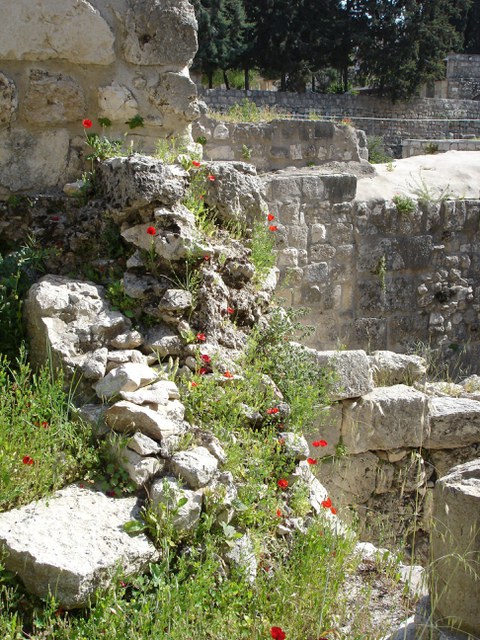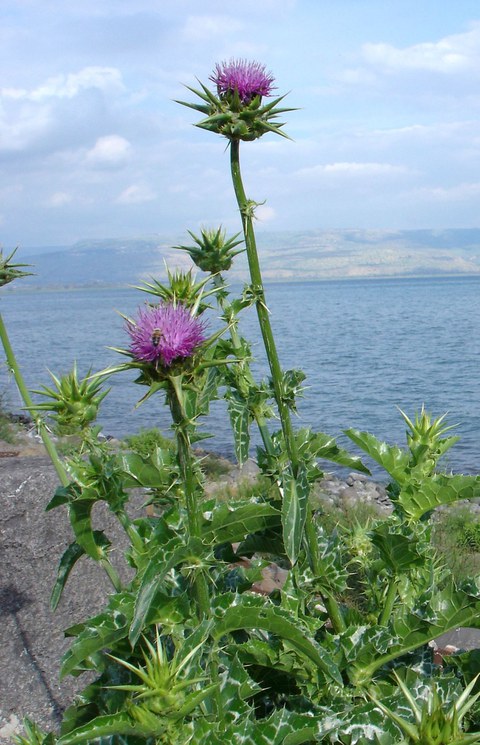Plants of the Bible
Plants play an important role in the Bible. In the language of the Bible, they illustrate the close relationship between the world experience and the world interpretation of the ancient oriental/antique human being, not only in connection with various agricultural activities such as sowing and harvesting, but also in observations of development and growth as well as the outward appearance of blossoms or fruits. Thus, in ancient thought, natural phenomena and plants, which can be experienced directly in life, are always inseparably and closely linked to superordinate, in a certain sense abstract contexts, ideas and concepts that provide, for example, deeper insights into the contexts of the world, or can provide advice for a successful life. In other words: they have symbolic qualities.
The project analyses the connection between different plants mentioned in the Bible and their respective interpretation potential. This opens up possibilities for us today to approach everyday life and thinking in the Ancient Orient/in Antiquity. A second focus is the research of the history of the reception of plant symbolism up to the occidental culture.
As a transfer project of the Chair of Biblical Theology, imparting knowledge plays a central role in the project. The project group, consisting of staff, doctoral students, postdocs, and students from various disciplines, annually publishes general educational materials, gives presentations, and provides guided tours. The project is thus constantly updated and thematically complemented. It offers students in particular the opportunity to develop forms of knowledge transfer under guidance, and to try out own ideas.
History of the project
2010 Under the patronage of Prof. Dr. Maria Häusl, short texts on the significance and cultural history of 34 selected plants are produced in collaboration with Dr. Barbara Ditsch from the Botanical Garden of TU Dresden. The aim is an exhibition on the theme at the 33rd German Protestant Church Congress in Dresden.
2011 With a view to the Protestant Church Congress (Evangelischer Kirchentag) from 3rd-7th June, the first teaching materials for children are developed. Within the framework of the Congress, guided tours and children's programmes on the plants of the Bible take place.
2013 With Pillnitz Palace & Park (Schloss &Park Pillnitz), the project finds a new cooperation partner for an exhibition. The project team thematically counsels the preparation team Church at the BUGA 2021. The Bundesgartenschau (BUGA) is a biennial federal horticulture show in Germany.
2013 For the first time, the project team presents its work at the Dresden Science Night and at the festival Elbhangfest.
2016 In the framework of the Pillnitz special exhibition The Gardener of the Maharajah, a booklet on The trade with plants between the Near East and India in biblical times is produced for the first time.
2017 Exhibition A biblical-floral journey from the Nile to the Jordan.
2018 The exhibition in the Hedge Walkways of the Pillnitz Palace Park is equipped with new exhibition boards.
NEWS
Public guided tours:
date tba
Contact
If you have any questions, please contact:
Publications
Books
Maria Häusl/Victor Lossau (Hg.): Balsambeet und Rosenhag, Paradiese und die Kultur der Gärten, Stuttgart 2021 (Sachbuch).
Tomas Gärtner in DNN 11.06.2021
review B. Collinet in bbs/2021
Maria Häusl (ed.), Vom Garten Eden bis zu Salomos Weinberg, Pflanzen der Bibel, Stuttgart 2018 (Sachbuch).
Review by Dr. Bettina Förster, Evangelische Akademie im Rheinland: https://www.youtube.com/watch?v=7a0ZTrk_6zY
Booklets
Themenheft „Der Garten als Sehnsuchtsort. Von den biblischen Anfängen bis zur Gegenwart“ zur Ausstellung im Schloss & Park Pillnitz (2020).
Begleitheft „Max von Sachsen - Priester. Gelehrter. Vegetarier. Ein sächsischer Prinz und die Flora Palästinas“ zur Ausstellung im Schloss & Park Pillnitz (2019).
Begleitheft „Eine biblisch-florale Reise vom Nil bis an den Jordan“ zur Ausstellung im Schloss & Park Pillnitz (2017).
Begleitheft „Der Handel mit Pflanzen zwischen dem Vorderen Orient und Indien in biblischer Zeit“ zur Ausstellung im Schloss & Park Pillnitz (2016).
Articles
Maria Häusl: Der Garten als Paradies und das Paradies als Garten, in: Maria Häusl/Victor Lossau (Hg.): Balsambeet und Rosenhag. Paradiese und die Kultur der Gärten, Stuttgart 2021, S. 13-16.
Victor Lossau: Gärten im Alten Orient und Ägypten, in: Maria Häusl/Victor Lossau (Hg.): Balsambeet und Rosenhag. Paradiese und die Kultur der Gärten, Stuttgart 2021, S. 20-25.
Maria Häusl/Rebecca Ullrich: Das Paradies und die kommende Welt im Alten Testament, in frühen jüdischen Schriften und im rabbinischen Judentum, in: Maria Häusl/Victor Lossau (Hg.): Balsambeet und Rosenhag. Paradiese und die Kultur der Gärten, Stuttgart 2021, S. 36-40.
Victor Lossau: Die Suche nach dem Paradies im Christentum, in: Maria Häusl/Victor Lossau (Hg.): Balsambeet und Rosenhag. Paradiese und die Kultur der Gärten, Stuttgart 2021, S. 41-45.
Victor Lossau: Das christliche Paradies als Utopie?, in: Maria Häusl/Victor Lossau (Hg.): Balsambeet und Rosenhag. Paradiese und die Kultur der Gärten, Stuttgart 2021, S. 46-50.
Victor Lossau/Thea Lautenschläger: Typische Pflanzen in den Gärten des Orient, in: Maria Häusl/Victor Lossau (Hg.): Balsambeet und Rosenhag. Paradiese und die Kultur der Gärten, Stuttgart 2021, S. 92-107.
Victor Lossau/Thea Lautenschläger: Typische Pflanzen in den Gärten des christlichen Europas, in: Maria Häusl/Victor Lossau (Hg.): Balsambeet und Rosenhag. Paradiese und die Kultur der Gärten, Stuttgart 2021, S. 108-123.
Victor Lossau/Marcus Köhler: Boden und Land, in: Maria Häusl/Victor Lossau (Hg.): Balsambeet und Rosenhag. Paradiese und die Kultur der Gärten, Stuttgart 2021, S. 130-134.
Victor Lossau/Marcus Köhler: Umzäunung und Grenzen, in: Maria Häusl/Victor Lossau (Hg.): Balsambeet und Rosenhag. Paradiese und die Kultur der Gärten, Stuttgart 2021, S. 135-141.
Victor Lossau/Marcus Köhler: Ordnung, Achsen und Quartiere, in: Maria Häusl/Victor Lossau (Hg.): Balsambeet und Rosenhag. Paradiese und die Kultur der Gärten, Stuttgart 2021, S. 142-149.
Victor Lossau/Marcus Köhler: Wege – Führung durch den Garten, in: Maria Häusl/Victor Lossau (Hg.): Balsambeet und Rosenhag. Paradiese und die Kultur der Gärten, Stuttgart 2021, S. 150-153.
Victor Lossau/Marcus Köhler: Wasser – Quelle des Lebens und der Freude, in: Maria Häusl/Victor Lossau (Hg.): Balsambeet und Rosenhag. Paradiese und die Kultur der Gärten, Stuttgart 2021, S. 154-160.
Victor Lossau: Licht und Schatten, in: Maria Häusl/Victor Lossau (Hg.): Balsambeet und Rosenhag. Paradiese und die Kultur der Gärten, Stuttgart 2021, S. 161-163.
Victor Lossau: Farben, Blüten und Blattwerk, in: Maria Häusl/Victor Lossau (Hg.): Balsambeet und Rosenhag. Paradiese und die Kultur der Gärten, Stuttgart 2021, S. 164-166.
Victor Lossau: Betörende und heilende Düfte, in: Maria Häusl/Victor Lossau (Hg.): Balsambeet und Rosenhag. Paradiese und die Kultur der Gärten, Stuttgart 2021, S. 167-169.
Victor Lossau/Marcus Köhler: Kurze Geschichte der Gartenkunst im christlichen Europa, in: Maria Häusl/Victor Lossau (Hg.): Balsambeet und Rosenhag. Paradiese und die Kultur der Gärten, Stuttgart 2021, S. 172-177.
Victor Lossau/Marcus Köhler: Berühmte Gärten, in: Maria Häusl/Victor Lossau (Hg.): Balsambeet und Rosenhag. Paradiese und die Kultur der Gärten, Stuttgart 2021, S. 177-194.
Maria Häusl: Faszination Garten, in: Maria Häusl/Victor Lossau (Hg.): Balsambeet und Rosenhag. Paradiese und die Kultur der Gärten, Stuttgart 2021, S. 243-244.
Andrea Pojer/Cornelia Aßmann/Victor Lossau: Vegetarismus, Tierschutz, Lebensreform und Abstinenz, in: Iris Kretschmann/André Thieme (Hg.): Seiner Zeit voraus! Prinz Max von Sachsen. Priester und Visionär, Dresden 2019, S. 127-141.
Presentations
Prof. Dr. Maria Häusl: „Die Steppe soll jubeln und blühen – Pflanzen der Bibel verstehen“ (Febr. 2020, Sächsische Landesbibliothek – Staats- und Universitätsbibliothek)
Dr. Cornelia Aßmann: „Vom Anfang und Ende. Pflanzen in der Bibel, die vom Werden und Vergehen berichten“ (Dez. 2019, Museum für Sächsische Volkskunst, Dresden)
Cornelia Aßmann: „Die Geschenke der drei Weisen Myrrhe und Weihrauch“ (Dez. 2018, Museum für sächsische Volkskunst Dresden)
Press reviews and articles on the Bible Plant Project
Article in the Dresden newspaper DNN (11th June 2021) "Grüne Gegenwelt" book review on "Balsambeet und Rosenhag. Paradiese und die Kultur der Gärten"
feinschwarz.net, Oct 2019 Wenn die Steppe jubelt und blüht
Sachsen Fernsehen, Sept 2019 Pflanzen der Bibel im Pillnitzer Schlossgarten
Articel in the Dresden newspaper DNN
Press Release (June 2012) des Bistums Dresden-Meissen zum Projekt "Pflanzen der Bibel"




